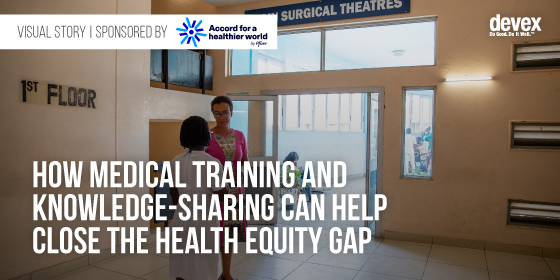|
It's not all doom and gloom in the food system world.
|
|
|
Greetings, Newswire readers! Devex is taking a summer hiatus this week. Instead of our regular Newswire, we are bringing you deep dives into some of this year’s key development issues. In this edition we explore the promising research into climate-resilient crops.
There’s a truism that grows more true by the day: Global shocks such as the COVID-19 pandemic and climate change have exposed the fragility of our food system, and it’s paramount that we transform it for the good of both people and the planet. The statistics tell an alarming story. Year-on-year progress on ending global hunger has reversed and stalled, with an estimated 733 million people going hungry last year, according to the United Nations’ latest State of Food Security and Nutrition in the World report. Nearly a quarter of the global population is moderately or severely food insecure, and over one-third is unable to afford a healthy diet. Rates of adult obesity and anemia in women are on the rise. The major drivers of hunger — conflict, climate change, and economic shocks — are occurring more often and at higher intensity, the report states, while climate change is the most prevalent reason for food insecurity and malnutrition. Meanwhile, food systems account for about one-third of human-made greenhouse gas emissions. Yet despite nearly half of habitable land being used for agriculture, global farming productivity is 21% lower than it could have been without anthropogenic climate change. It’s all prompting a rethink of the food we eat and how we grow it. “There is a growing awareness, I would say a megatrend, that our food systems need to be more resilient in general, and in particular more climate-resilient,” says Stefan Schmitz, executive director at the Crop Trust, which works to conserve crop diversity and funds gene banks worldwide. The world is increasingly paying attention to the need to protect and invest in diversity, resilience, and sustainability in the food system, according to Schmitz. This includes a push to expand beyond the past few decades’ focus on a small group of staple crops — such as wheat, rice, and maize. It’s breathing new life into research aimed at increasing crop diversity and identifying more resilient crop varieties. “We have to be more courageous” with research budgets, Schmitz says. “And the more attention to fonio, bambara, teff, sorghum, all kinds of millets — we think at the end of the day it will pay off.” |
|
VACS-packed crops
There’s one particular initiative tying it all together: the Vision for Adapted Crops and Soils, or VACS. It’s the brainchild of Cary Fowler, the U.S. special envoy for global food security, and it’s aimed at building a resilient food system through climate-resilient crops grown in healthy soils.
The $150 million initiative of the U.S. State Department got its start in Africa last year and recently made its first foray into Central America via Guatemala. It’s a chance to revive “orphan crops” — or as Fowler and others call them, “opportunity crops” — which tend to be traditional and indigenous crops that have been plagued by underinvestment but have the potential to improve food and nutrition security in the context of climate change. In Africa, VACS is focused on about 60 crops that are among the most nutritious available in the continent’s five subregions, from amaranth to cocoyams to bushmangoes. “The crops were analyzed on their potential to improve the nutrition of people and soils alike — and were assessed with large-language artificial intelligence models to predict how they would adapt to different climate scenarios,” my colleague Elissa Miolene writes. And in Guatemala, VACS is working with local partners to research beans and biofortified maize. Its implementers group — which aligns efforts and collaboration to improve food security and sustainable agricultural development — includes the Food and Agriculture Organization, the international agricultural research consortium CGIAR, the International Fund for Agricultural Development, and most recently the Crop Trust. |
|
Roots of Change: Sponsored by Conrad N. Hilton Foundation
Opinion: The time is right for donors to deliver on locally led development
Donors committing to allocate more of their grantmaking to locally led organizations and shift more power to them is an important first step but requires fundamental changes. Peter Laugharn of the Conrad N. Hilton Foundation weighs in. |
|
Banking on a seed
The small but mighty seed may hold some of the answers to the interconnected problems of biodiversity loss, climate change, and food insecurity — and where better to keep seeds safe than in seed banks?
These troves of plant genetic material — located in facilities all around the world — contain the traits scientists need to improve crops’ resilience to climate change and disease, as well as their nutritional value. They “enable researchers, breeders, and farmers to access the diversity they need when they need it. “They can breed new varieties, or perhaps return to communities heirloom varieties they once lost but which now perfectly match the climatic conditions,” the Crop Trust’s Schmitz and Geoffrey Hawtin wrote in a recent opinion piece for Devex. Gene banks hold the keys to developing drought-resistant or hardier crops that do everything from adding nitrogen to soil, saving water, and bringing nutrients to livestock. Earlier this year I had a fascinating conversation with Hawtin and Fowler just after they won the World Food Prize for their work creating the Svalbard Global Seed Vault, a backup collection of the world’s seed banks located on a frosty Norwegian archipelago. Though Svalbard has come to be known as the “doomsday vault,” the two don’t particularly like that moniker. Rather, they want Svalbard — and other gene banks around the world — to be useful long before doomsday ever comes. “People don’t understand that extinction is a process. It’s not an event,” Fowler told me. “Extinction doesn’t really happen when the last individual dies. It happens when the species loses the ability to evolve. And what we’ve tried to do is to conserve all the options for the future for our agricultural crops that will enable them to evolve in a rapidly changing world.” |
|
SPECIAL NOTICE
Explore the series – Ctrl Shift Equality
Millions of women and girls are facing barriers in the digital world, from unequal access to harmful biases and even online violence. Ctrl Shift Equality explores this urgent challenge, highlighting solutions and envisioning a future where technology empowers women and girls globally. Explore the series today. |
|
The early bird gets the … rice
Despite obvious signs of a changing climate — last month saw some of the hottest days in recorded history — research into climate-resilient agriculture is being hampered by tightening budgets around the world. Investment will have to increase on a large scale in order to transform our food system for a warming planet without devastating ecosystems. To that end, there’s a growing interest in heat-tolerant crop varieties. “While tomatoes, cassava, and pearl millet are known to be naturally able to withstand higher temperatures, scientists are looking at whether staple crops such as wheat, barley, and rice could be genetically adapted in the lab to do the same,” Devex contributor Rebecca Root writes. Some fascinating research is now underway to strengthen food security by identifying, genetically modifying, and distributing crops that are better adapted to extreme heat. For example, the International Center for Agricultural Research in the Dry Areas has a whole program dedicated to high-yielding and heat-tolerant varieties of wheat in sub-Saharan Africa. And in Japan, researchers have discovered a wild variety of rice that flowers at 6 a.m. versus the typical 9 a.m. — meaning pollen are likelier to survive because the flowers open before it’s too hot — which the International Rice Research Institute is incorporating into various genetic backgrounds to create new rice varieties. 
|
|
Thank you for reading today’s Newswire, edited by Honesty Pern, copy edited by Nicole Tablizo, and produced by Mariane Samson. Have a news tip? Email [email protected]. Forwarded by a friend?
Sign up here to receive the Newswire directly.
|
|
Devex thanks our partners for supporting our newsletters.
Our editorial content remains independent. Interested in partnering with us? Get in touch. |
|
Connect with us:
|






